
Lieutenant Colonel Sir Francis Edward Younghusband, was a British Army officer, explorer and spiritual writer. He is remembered for his travels in the Far East and Central Asia; especially the 1904 British expedition to Tibet, led by himself, and for his writings on Asia and foreign policy. Younghusband held positions including British commissioner to Tibet and president of the Royal Geographical Society.

Karakol, formerly Przhevalsk, is the fourth-largest city in Kyrgyzstan, near the eastern tip of Lake Issyk-Kul, about 150 kilometres (93 mi) from the Kyrgyzstan–China border and 380 kilometres (240 mi) from the capital Bishkek. It is the administrative capital of Issyk-Kul Region. Its area is 44 square kilometres (17 sq mi), and its resident population was 84,351 in 2021. To the north, on highway A363, is Tüp, and to the southwest Jeti-Ögüz resort.

Qinghai Lake is the largest lake in China. Located in an endorheic basin in Qinghai Province, to which it gave its name, Qinghai Lake is classified as an alkaline salt lake. The lake has fluctuated in size, shrinking over much of the 20th century but increasing since 2004. It had a surface area of 4,317 km2 (1,667 sq mi), an average depth of 21 m (69 ft), and a maximum depth of 25.5 m (84 ft) in 2008.
The foreign relations of Tibet are documented from the 7th century onward, when Buddhism was introduced by missionaries from India and Nepal. The Tibetan Empire fought with the Tang dynasty for control over territory dozens of times, despite peace marriage twice. Tibet was conquered by the Mongol Empire and that changed its internal system of government, introducing the Dalai Lamas, as well as subjecting Tibet to political rule under the Yuan dynasty. Tibetan foreign relations during the Ming dynasty are opaque, with Tibet being either a tributary state or under full Chinese sovereignty. But by the 18th century, the Qing dynasty indisputably made Tibet a subject. In the early 20th century, after a successful invasion, Britain established a trading relationship with Tibet and was permitted limited diplomatic access to "Outer Tibet", basically Shigatse and Lhasa. Britain supported Tibetan autonomy under the 13th Dalai Lama but did not contest Chinese suzerainty; while "Inner Tibet", areas such as Amdo and Kham with mixed Chinese and Tibetan populations to the east and north, remained nominally under the control of the Republic of China although that control was seldom effective. Although the sovereignty of Tibet was unrecognized, Tibet was courted in unofficial visits from Nazi Germany, Imperial Japan, and the United States during and after World War II. The foreign relations of Tibet ended with the Seventeen Point Agreement that formalized Chinese sovereignty over most all of political Tibet in 1951.

Kham is one of the three traditional Tibetan regions, the others being Domey also known as Amdo in the northeast, and Ü-Tsang in central Tibet. The official name of this Tibetan region/province is Dotoe. The original residents of Kham are called Khampas, and were governed locally by chieftains and monasteries. Kham covers a land area distributed in multiple province-level administrative divisions in present-day China, most of it in Tibet Autonomous Region and Sichuan, with smaller portions located within Qinghai and Yunnan.

The 13th Dalai Lama, Thubten Gyatso was the 13th Dalai Lama of Tibet, enthroned during a turbulent modern era. He presided during the Collapse of the Qing Dynasty, and is referred to as "the Great Thirteenth", responsible for redeclaring Tibet's national independence, and for his national reform and modernization initiatives.

Pyotr Kuzmich Kozlov was a Russian and Soviet traveller and explorer who continued the studies of Nikolai Przhevalsky in Mongolia and Tibet.
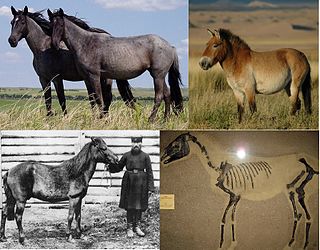
The wild horse is a species of the genus Equus, which includes as subspecies the modern domesticated horse as well as the endangered Przewalski's horse. The European wild horse, also known as the tarpan, that went extinct in the late 19th or early 20th century has previously been treated as the nominate subspecies of wild horse, Equus ferus ferus, but more recent studies have cast doubt on whether tarpans were truly wild or if they actually were feral horses or hybrids.

Przewalski's gazelle is a member of the family Bovidae, and in the wild, is found only in China. Once widespread, its range has declined to six populations near Qinghai Lake. The gazelle was named after Nikolai Przhevalsky, a Russian explorer who collected a specimen and brought it back to St. Petersburg in 1875.

The location of Tibet, deep in the Himalaya mountains, made travel to Tibet extraordinarily difficult at any time, in addition to the fact that it traditionally was forbidden to all western foreigners. The internal and external politics of Tibet, China, Bhutan, Assam, and the northern Indian kingdoms combined rendered entry into Tibet politically difficult for all Europeans. The combination of inaccessibility and political sensitivity made Tibet a mystery and a challenge for Europeans well into the 20th century.

Ligularia przewalskii, also called Przewalski's leopardplant and Przewalski's golden ray, is a species of perennial herbaceous plant in the genus Ligularia and the family Asteraceae, native to damp places in Mongolia and Northern China. Named after the Russian explorer Nikolai Przhevalsky, it used to be called Senecio przewalskiiMaxim.
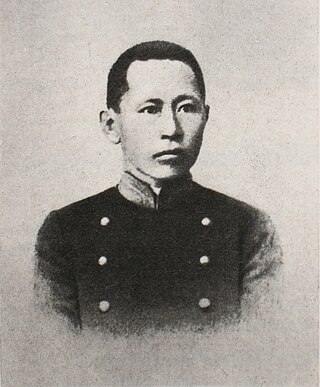
Gombojab Tsybikov was a Russian explorer of Tibet from 1899 to 1902. Tsybikov specialized in ethnography, Buddhist Studies, and after 1917 was an important educator and statesman in Siberia and Mongolia.

Tibet was a de facto independent state in East Asia that lasted from the collapse of the Qing dynasty in 1912 until its annexation by the People's Republic of China in 1951.
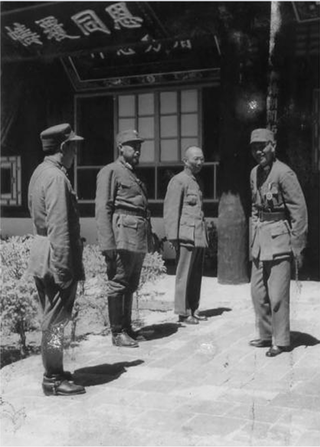
The Ma clique fought a series of military campaigns between 1917 and 1949 against unconquered Amchok and Ngolok (Golok) tribal Tibetan areas of Qinghai (Amdo), undertaken by two Hui commanders, Gen. Ma Qi and Gen. Ma Bufang, on behalf of the Beiyang and Kuomintang governments of the Republic of China. The campaigns lasted between 1917 and 1949. The conflict was spurred by multiple factors, notably for economic and socio-political reasons rather than by any racial or religious enmity.
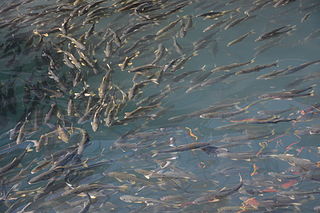
Schizopygopsis przewalskii is a species of cyprinid that is endemic to the Lake Qinghai basin in China, where it is the dominant fish species. S. przewalskii is a planktivore with a main population that migrates from the lake to rivers to spawn and another that lives its entire life in the nearby Ganzi River. The species is listed as endangered on the China Species Red List due to overfishing and habitat loss, which has led to suspension of its commercial fishery four times since 1989.

Przevalski's nuthatch, originally given the nomen nudumSitta eckloni, is a bird species in the family Sittidae, collectively known as nuthatches. Long regarded as a subspecies of the white-cheeked nuthatch, it nevertheless differs significantly in morphology and vocalizations. Both S. przewalskii and S. leucopsis have been regarded as closely related to the North American white-breasted nuthatch. It is a medium-sized nuthatch, measuring about 13 cm (5 in) in length. Its upper body is a dark gray-blue or slate color, becoming dark blue-black at the crown. The cheeks and throat are a white buff-orange, turning to a rich cinnamon on the underparts that intensifies in color on the sides of the breast. Vocalizations consist of alternating series of ascending whistles and short notes.
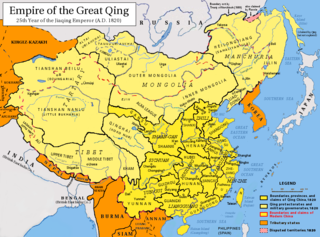
The Qing dynasty in Inner Asia was the expansion of the Qing dynasty's realm in Inner Asia in the 17th and the 18th century AD, including both Inner Mongolia and Outer Mongolia, both Manchuria and Outer Manchuria, Tibet, Qinghai and Xinjiang.

Chengguan, also known as Huangyuan and by other names, is a town on the Huangshui River in Qinghai, China. It serves as the seat of Huangyuan County, lying about 45 km (28 mi) upstream (west) from the provincial capital of Xining and approximately 45 km (28 mi) east of Qinghai Lake. Chengguan has a 600-year history as a frontier trading post between the Chinese, Mongolian, and Tibetan cultural spheres.

Eremias przewalskii, commonly known as the Gobi racerunner, is a species of lizard in the family Lacertidae. The species is endemic to Asia.

Przewalski's toadhead agama, also known as Tsarewsky's toadhead agama, or Steindachner's toadhead agama, is a species of agamid lizard found in China and Mongolia. This species was named after Nikolay Przhevalsky, a Russian Imperial geographer and explorer of Central and East Asia.






















